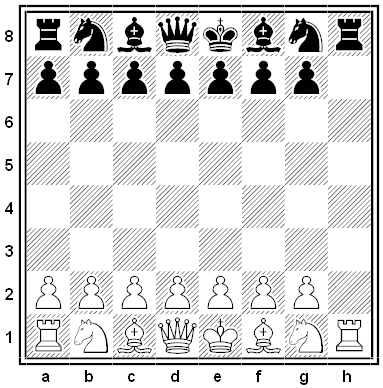
By Éric Angelini. A regular chess game reached this position after Black’s fifth move. Four pieces have moved. Which ones?

By Éric Angelini. A regular chess game reached this position after Black’s fifth move. Four pieces have moved. Which ones?
This is interesting — in order for a simple arch to stand, its shape when inverted must fit into the limits described by a hanging chain (a catenary).
Spanish Catalan architect Antoni Gaudí followed this principle in designing some of his buildings — he created inverted models and let the shapes of hanging chains or weighted strings determine the shapes of the arches.
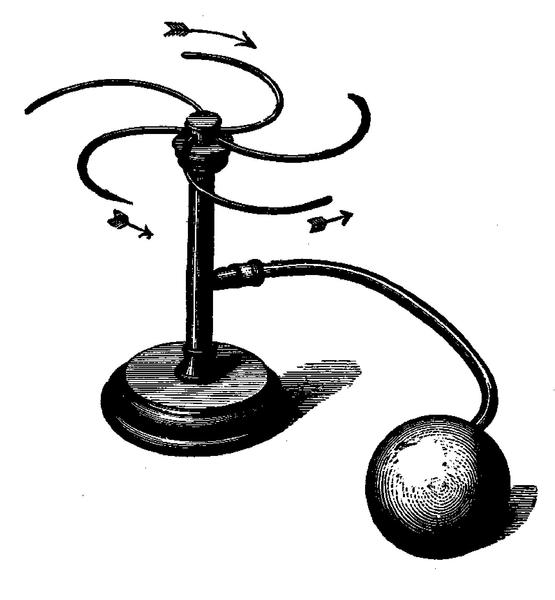
In the early 1940s a curious question began to circulate among the members of the Princeton physics department. An ordinary lawn sprinkler like the one shown here would turn clockwise (in the direction of the long arrow) as its jets ejected water (short arrows). If you reversed this — that is, if you submerged the sprinkler in a tank of water and induced the jets to suck in the fluid — would the sprinkler turn in the opposite direction?
The problem is associated with Richard Feynman, who was a grad student at the time (and who destroyed a glass container in the university’s cyclotron laboratory trying to find the answer).
In fact Ernst Mach had first asked the question in an 1883 textbook. The answer, briefly, is no: The submerged sprinkler doesn’t turn counterclockwise because counterbalancing forces at the back of the nozzle result in no net torque. Experiments tend to bear this out, although in some cases the sprinkler turns slightly counterclockwise, perhaps due to the formation of a vortex within the sprinkler body.
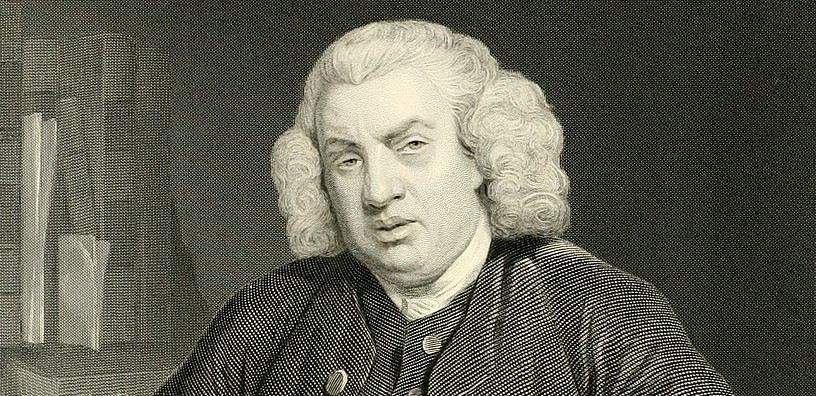
During a visit to a club in 1775, Samuel Johnson was observed to put several Seville oranges into his pocket after squeezing their juice into a drink he’d made for himself. The friends who saw this “seemed to think that he had a strange unwillingness to be discovered.” Visiting Johnson the next morning and seeing the orange peels scraped and cut into pieces on a table, James Boswell asked about them:
JOHNSON. ‘I have a great love for them.’
BOSWELL. ‘And pray, Sir, what do you do with them? You scrape them it seems, very neatly, and what next?’
JOHNSON. ‘Let them dry, Sir.’
BOSWELL. ‘And what next?’
JOHNSON. ‘Nay, Sir, you shall know their fate no further.’
BOSWELL. ‘Then the world must be left in the dark. It must be said (assuming a mock solemnity) he scraped them, and let them dry, but what he did with them next he never could be prevailed upon to tell.’
JOHNSON. ‘Nay, Sir, you should say it more emphatically:–he could not be prevailed upon, even by his dearest friends, to tell.’
I don’t think this has ever been fully explained, but Boswell notes that, in a letter to Mrs. Piozzi, Johnson had once recommended “‘dried orange-peel, finely powdered,’ as a medicine.”
A thought-provoking piece of nonsense by Russian absurdist poet Daniil Kharms:
Philosopher!

Part of New York is standing still. In 1978, artist Alan Sonfist reclaimed a rubble-strewn lot on the corner of West Houston Street and La Guardia Place in Greenwich Village and re-established the vegetation, soil and rock formations that had existed there before the Western settlers arrived.
“As in war monuments that record the life and death of soldiers, the life and death of natural phenomena such as rivers, springs and natural outcroppings need to be remembered,” he wrote in a 1968 manifesto proposing the project. Interestingly, he’d hoped to do even more than this: “On Canal Street I propose to create a marshland and a stream; on Spring Street I propose to restore the natural spring; in front of City Hall I propose to restore the historical lake. There are a series of fifty proposals I have made for the City of New York.”
Only this one, called Time Landscape, has been realized. But it’s still growing after 44 years, a tiny piece of history that Sonfist says helps the city remember its heritage.
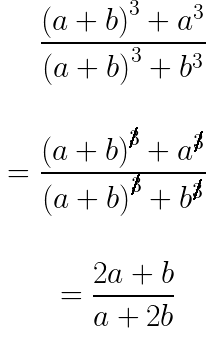
I don’t know whether this is contrived or whether a student offered it on an actual exam — Ed Barbeau presented “this little beauty of a howler” in the January 2002 College Mathematics Journal, citing Ross Honsberger of the University of Waterloo in Ontario.
In his Harmonices Mundi of 1619, Johannes Kepler wrote, “The heavenly motions are nothing but a continuous song for several voices, to be perceived by the intellect, not by the ear; a music which, through discordant tensions, through syncopations and cadenzas as it were, progresses toward certain pre-designed six-voiced cadences, and thereby sets landmarks in the immeasurable flow of time.” In 1979 Yale geologist John Rodgers and musician Willie Ruff scaled up the frequencies of the planetary orbits into the range of human hearing so that Kepler’s “harmony of the world” could become audible:
Mercury, as the innermost planet, is the fastest and the highest pitched. It has a very eccentric orbit (as planets go), which it traverses in 88 days; its song is therefore a fast whistle, going from the E above the piano (e′′′′′) down more than an octave to about C# (c#′′′′) and back, in a little over a second. Venus and Earth, in contrast, have nearly circular orbits. Venus’s range is only about a quarter tone, near the E next above the treble staff (e′′′); Earth’s is about a half tone, from G (g′′) to G# at the top of that staff. … Next out from Earth is Mars, again with an eccentric orbit … it ranges from the C above middle C (c′′) down to about F# (f#′) and back, in nearly 10 seconds. The distance from Mars to Jupiter is much greater than that between the inner planets … and Jupiter’s song is much deeper, in the baritone or bass, and much slower. It covers a minor third, from D to B (D to B1) just below the bass staff. Still farther out and still lower is Saturn, only a little more than a deep growl, in which a good ear can sometimes hear the individual vibrations. Its range is a major third, from B to G (B2 to G2), the B at the top being just an octave below the B at the bottom of Jupiter’s range. Thus the two planets together define a major triad, and it may well have been this concord … that made Kepler certain he had cracked the code and discovered the secret of the celestial harmony.
(The outer planets, discovered after Kepler’s time, are represented here with rhythmic beats.) “The Earth sings Mi, Fa, Mi,” Kepler wrote. “You may infer even from the syllables that in this our home misery and famine hold sway.”
(John Rodgers and Willie Ruff, “Kepler’s Harmony of the World: A Realization for the Ear,” American Scientist 67:3 [May-June 1979], 286-292.)
In The Interpretation of Dreams, Freud recalls “the defensive argument of a man who was accused by his neighbour of having returned a kettle to him in a damaged condition”:
In the first place, he said, he had returned the kettle undamaged; in the second, it already had holes in it when he borrowed it; and thirdly, he had never borrowed the kettle from his neighbour at all.
“But so much the better,” Freud notes. “If even one of these three methods of defence is recognised as valid, the man must be acquitted.”
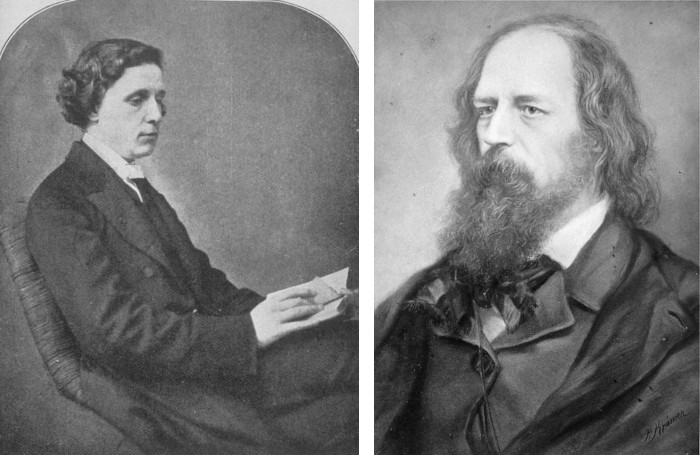
Lewis Carroll and Alfred, Lord Tennyson, became improbable acquaintances in the 1850s, a few years before Carroll published Alice’s Adventures in Wonderland. The young author sent a letter to his cousin, May 11, 1859, after one memorable visit to the laureate:
Tennyson told us that often on going to bed after being engaged on composition he had dreamed long passages of poetry (‘You, I suppose,’ turning to me, ‘dream photographs?’) which he liked very much at the time, but forgot entirely when he woke. One was an enormously long one on fairies, where the lines from being very long at first gradually got shorter and shorter, till it ended with fifty or sixty lines of two syllables each! The only bit he ever remembered enough to write down was one he dreamed at ten years old, which you may like to possess as a genuine unpublished fragment of the Laureate, though I think you will agree with me that it gives very little indication of his future poetic powers:—
May a cock-sparrow
Write to a barrow?
I hope you’ll excuse
My infantine muse.
(Lewis Carroll, “A Visit to Tennyson,” Strand, June 1901. See Pillow Verse and Night Work.)